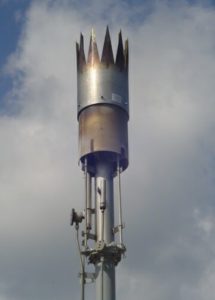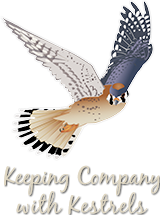The photos below show a burned American Kestrel and Red-tailed hawk. Burners are used in many industries to eliminate gases. In landfills, methane burners are the ‘green’ way to reduce toxic gas emissions produced from decomposing material at landfills. Birds may try to land on a burner that is flaring and scorch their feathers and other body parts. Some burners are on intermittently, so a raptor already perched on the flare when the flare is turned on, can sustain fatal results. Raptors can also simply fly over the flare and singe their feathers, rendering them flightless. Then they fall victim to ground predators or starve before they can replace feathers.


Methane Burner Best Management Practices
The proactive approach is to retrofit a “crown” on the burner to prevent birds from landing on the top of the burner. Methane burns clear, so the birds can not anticipate what they are flying into. This crown discourages even the prospect of perching with its sharp uncomfortable looking tips and narrow spaces between spikes.


Please feel free to download “Methane Burner Impacts on Raptors”. This document summarizes the problem and provides best management practices to reduce methane burner fatalities and injuries to raptors. Click on the red button below to view. (The report is a PDF that can be read by Adobe Acrobat Reader. If you do not have this software, please click here to get Acrobat Reader.)
This project is supported in part by Covanta Energy Corporation, Nuttall Ornithological Club, Eastern Mass Hawk Watch and South Shore Bird Club.

